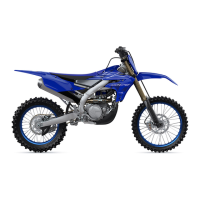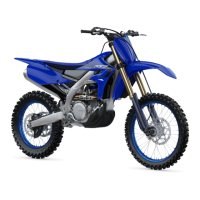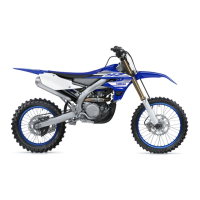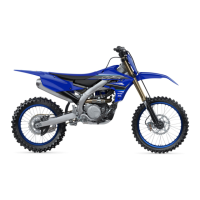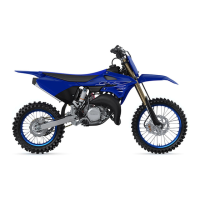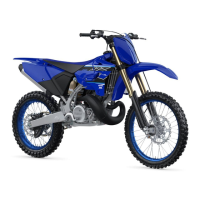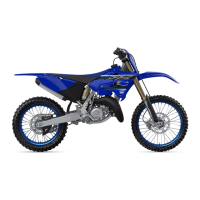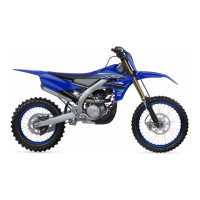Do you have a question about the Yamaha YZ450FX 2021 and is the answer not in the manual?
Crucial safety guidelines and rider responsibilities for safe operation.
Identifies the location and meaning of important labels and vehicle identification.
Lists and describes included parts, and covers critical pre-service information.
Details on electrical system handling and specialized tools for maintenance.
Explains vehicle controls, instruments, and starting/break-in procedures.
Provides overall vehicle dimensions and detailed engine component specifications.
Details chassis, electrical system, and fastener torque specifications.
Illustrates the proper routing of various cables and hoses on the frame and engine.
Outlines recommended maintenance schedules based on usage intervals.
Details essential checks and maintenance before operating the machine.
Covers engine-related checks, adjustments, and maintenance procedures.
Details checks and adjustments for chassis components like brakes and suspension.
Covers checks and maintenance procedures for the vehicle's electrical system.
Covers procedures for removing and installing seat, side covers, and number plates.
Details procedures for front wheel, rear wheel, and chain drive maintenance.
Covers procedures for removing, disassembling, and installing front and rear brakes.
Details procedures for handlebar, front fork, and steering head maintenance.
Covers procedures for rear shock absorber and swingarm maintenance.
Details procedures for removing, checking, and installing the drive chain.
Provides diagrams and charts for the engine oil lubrication system.
Details procedures for removing and installing the engine and exhaust system.
Covers procedures for camshaft and cylinder head removal, checking, and installation.
Details procedures for valves, pistons, cylinder, and generator maintenance.
Covers procedures for starter clutch, electric starter, and clutch maintenance.
Details procedures for shift shaft, oil pump, crankcase, and crankshaft maintenance.
Covers procedures for removing, checking, and installing the transmission.
Provides schematic diagrams of the vehicle's cooling system components.
Details procedures for radiator removal, checking, and installation.
Covers procedures for water pump removal, checking, and assembly.
Details procedures for removing, checking, and installing the fuel tank and pump.
Covers procedures for removing, checking, and adjusting the throttle body.
Provides circuit diagram and troubleshooting for the ignition system.
Includes circuit diagram and troubleshooting for the electric starting system.
Provides circuit diagram and troubleshooting for the charging system.
Includes circuit diagram and troubleshooting for the vehicle's signaling system.
Covers circuit diagram, ECU self-diagnostics, and troubleshooting for the F.I. system.
Provides circuit diagram and troubleshooting for the fuel pump system.
Details checks for various electrical components like switches, fuses, and sensors.
Provides general troubleshooting tips and addresses engine starting issues.
Addresses common problems and solutions for the clutch and transmission.
Covers troubleshooting for overheating and poor brake performance.
Addresses issues related to suspension stiffness, leaks, and handlebar wobble.
Covers troubleshooting for charging, signaling, and fuel system malfunctions.
Lists fault codes, items, and corresponding pages for F.I. system diagnostics.
Details diagnostic codes for sensor operations and their display values.
Provides diagnostic codes for actuator operations, including ignition coil and injector.
Discusses tuning aspects like gear ratio selection and tire pressure adjustment.
Explains how to adjust front fork settings for optimal performance.
Provides guidelines for adjusting rear shock absorber spring preload and damping.
Details front and rear suspension adjustments based on specific riding symptoms.
Illustrates the electrical system layout and component connections.
Provides a legend for wire colors used in the wiring diagram.
Crucial safety guidelines and rider responsibilities for safe operation.
Identifies the location and meaning of important labels and vehicle identification.
Lists and describes included parts, and covers critical pre-service information.
Details on electrical system handling and specialized tools for maintenance.
Explains vehicle controls, instruments, and starting/break-in procedures.
Provides overall vehicle dimensions and detailed engine component specifications.
Details chassis, electrical system, and fastener torque specifications.
Illustrates the proper routing of various cables and hoses on the frame and engine.
Outlines recommended maintenance schedules based on usage intervals.
Details essential checks and maintenance before operating the machine.
Covers engine-related checks, adjustments, and maintenance procedures.
Details checks and adjustments for chassis components like brakes and suspension.
Covers checks and maintenance procedures for the vehicle's electrical system.
Covers procedures for removing and installing seat, side covers, and number plates.
Details procedures for front wheel, rear wheel, and chain drive maintenance.
Covers procedures for removing, disassembling, and installing front and rear brakes.
Details procedures for handlebar, front fork, and steering head maintenance.
Covers procedures for rear shock absorber and swingarm maintenance.
Details procedures for removing, checking, and installing the drive chain.
Provides diagrams and charts for the engine oil lubrication system.
Details procedures for removing and installing the engine and exhaust system.
Covers procedures for camshaft and cylinder head removal, checking, and installation.
Details procedures for valves, pistons, cylinder, and generator maintenance.
Covers procedures for starter clutch, electric starter, and clutch maintenance.
Details procedures for shift shaft, oil pump, crankcase, and crankshaft maintenance.
Covers procedures for removing, checking, and installing the transmission.
Provides schematic diagrams of the vehicle's cooling system components.
Details procedures for radiator removal, checking, and installation.
Covers procedures for water pump removal, checking, and assembly.
Details procedures for removing, checking, and installing the fuel tank and pump.
Covers procedures for removing, checking, and adjusting the throttle body.
Provides circuit diagram and troubleshooting for the ignition system.
Includes circuit diagram and troubleshooting for the electric starting system.
Provides circuit diagram and troubleshooting for the charging system.
Includes circuit diagram and troubleshooting for the vehicle's signaling system.
Covers circuit diagram, ECU self-diagnostics, and troubleshooting for the F.I. system.
Provides circuit diagram and troubleshooting for the fuel pump system.
Details checks for various electrical components like switches, fuses, and sensors.
Provides general troubleshooting tips and addresses engine starting issues.
Addresses common problems and solutions for the clutch and transmission.
Covers troubleshooting for overheating and poor brake performance.
Addresses issues related to suspension stiffness, leaks, and handlebar wobble.
Covers troubleshooting for charging, signaling, and fuel system malfunctions.
Lists fault codes, items, and corresponding pages for F.I. system diagnostics.
Details diagnostic codes for sensor operations and their display values.
Provides diagnostic codes for actuator operations, including ignition coil and injector.
Discusses tuning aspects like gear ratio selection and tire pressure adjustment.
Explains how to adjust front fork settings for optimal performance.
Provides guidelines for adjusting rear shock absorber spring preload and damping.
Details front and rear suspension adjustments based on specific riding symptoms.
Illustrates the electrical system layout and component connections.
Provides a legend for wire colors used in the wiring diagram.
| Bore x Stroke | 97.0mm x 60.8mm |
|---|---|
| Compression Ratio | 12.8:1 |
| Ignition | TCI: Transistor Controlled Ignition |
| Final Drive | Chain |
| Suspension / Front | KYB® Speed-Sensitive System, inverted fork; fully adjustable, 12.2-in travel |
| Suspension / Rear | KYB® single shock; fully adjustable, 12.5-in travel |
| Brakes / Front | Hydraulic disc, 270mm |
| Brakes / Rear | Hydraulic disc, 245mm |
| Tires / Front | 80/100-21 Dunlop® Geomax MX33F |
| Seat Height | 37.6 in |
| Wheelbase | 58.3 in |
| Fuel Capacity | 2.2 gal |
| Engine Type | Liquid-cooled DOHC 4-stroke; 4 valves |
| Transmission | 5-speed |
| Tires / Rear | 120/90-18 |
| Fuel Delivery | Fuel Injection |
